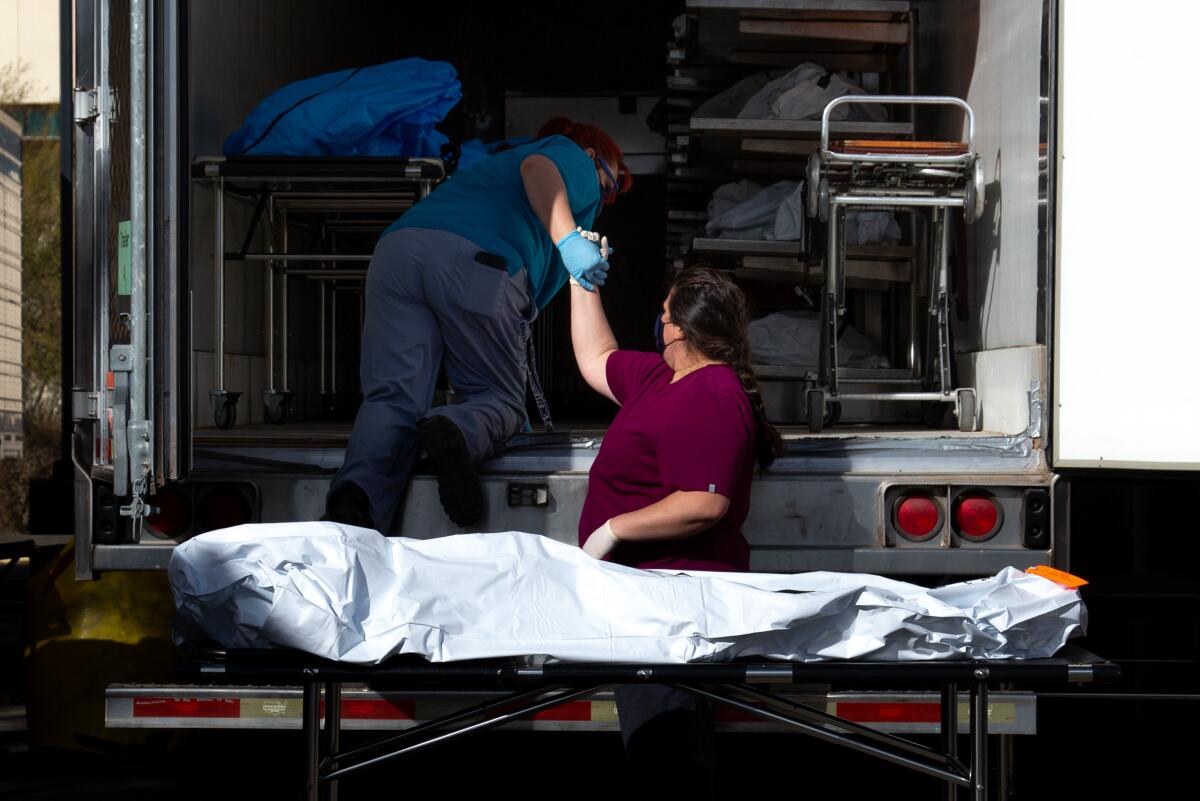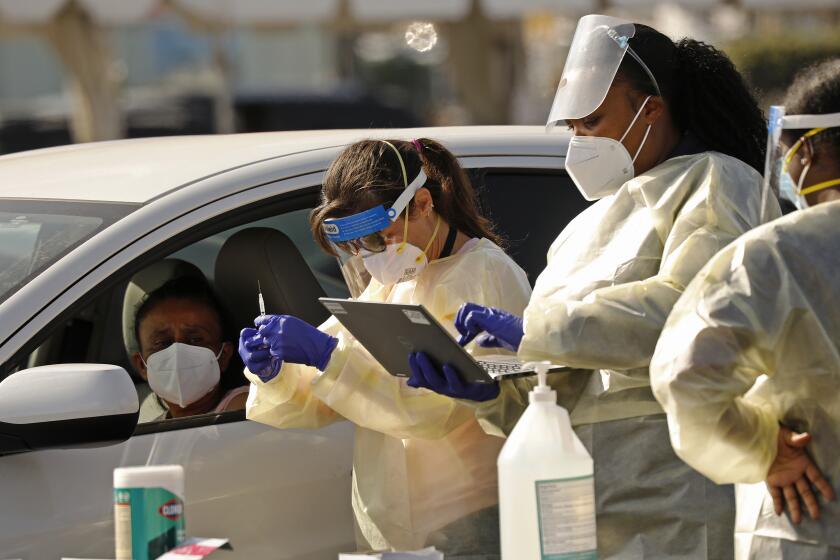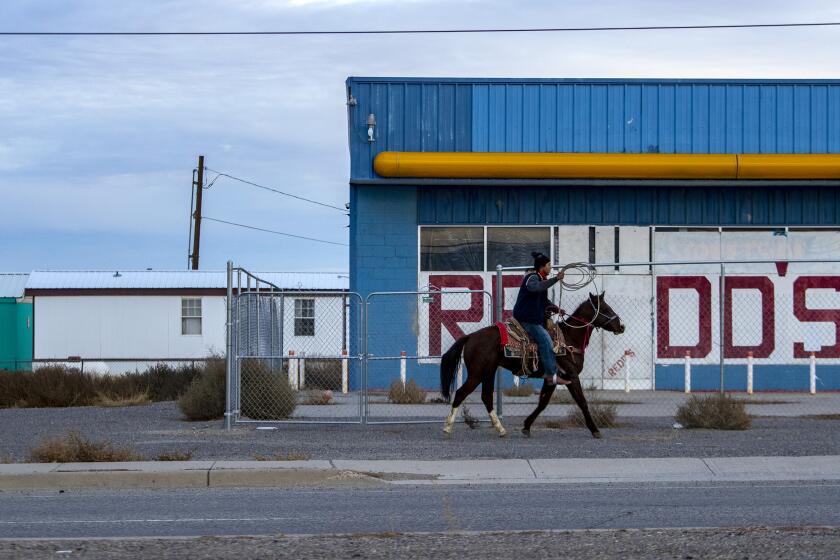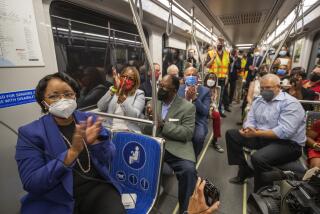Arizona surpasses California as state with the worst coronavirus infection rate

- Share via
PHOENIX — When it comes to the COVID-19 pandemic, few parts of the country would look to California — with its record-setting infections, jammed hospitals and confusing vaccine rollout — as better off.
Then there’s Arizona.
This state of 7.2 million now has the worst per capita coronavirus infection rate in the nation, according to the Centers for Disease Control and Prevention. Hospitals are filling up, with a scant 150 intensive care unit beds available statewide at any time. Rural areas, including farm-rich Yuma, resort to flying patients to Phoenix. The rate of residents getting tested is among the 10 lowest in America.
As the mask-up and shut-it-down strategy has governed vast swaths of California to stem a winter spike of the virus, its more politically-conservative neighbor to the east has doubled-down on a starkly different approach, refusing statewide mask measures, allowing indoor dining and bars, and reversing a decision this month to cancel high school sports.
For a virus that depends on people breathing in close quarters to each other in order to spread, Arizona “has created the perfect climate,” said Will Humble, executive director of the Arizona Public Health Assn. “It’s a recipe for disaster. It was California that was the hot spot. But we did nothing to stop the surge. Now, it’s us.”
So much so that a limited number of appointments at the two state-run vaccination sites were snatched up within hours this week and are now fully booked for February.
Scenes of the pandemic’s dark winter have become familiar in California since much of the state went under the strictest closure measures last year: Late-night sirens on empty streets as ambulances rush to overbooked hospitals. Lines at grocery stores under capacity caps. Shuttered restaurants and gyms. Zoom schooling. Delays in vaccine distribution.
A similar sense of foreboding has unfolded in Arizona’s Yuma County, where migrant field workers and farmhands have been hit particularly hard in what is known as the nation’s “salad bowl.” About 20% of tests there are coming back positive, compared with 14% in the state. During the pandemic, around 1 in 6 residents of the region have become infected. Army Reserve nurses now fly in to aid struggling healthcare workers.
But in Phoenix and other cities, life goes on as if the virus can be willed away by swagger and sheer defiance.
Experts say California’s brutal winter COVID-19 surge is largely driven by complacency on masking and distancing. One calls it ‘COVID resentment.’
This week, a downtown Phoenix concert hall where more than 100 people stood shoulder to shoulder for a hip-hop show made local headlines. Not because it happened. But because the venue, one of many to operate in the region with lax enforcement of rules on crowded indoor events, got caught for having an audience larger than 50 without a permit and lost its liquor license.
In Tucson, the state’s second-largest city, bars won a temporary reprieve in court this week against a short-lived 10 p.m. curfew put into place to stem late-night indoor crowds.
“I get it, people are incredibly fatigued by the virus. Pretending it does not exist is not the solution,” said Joshua LaBaer, a diagnostics expert and director of Arizona State University’s Biodesign Institute research center. LaBaer, whose center runs test sites across the state, estimated that “between 1 in 10 and 1 in 20 people in Arizona currently have an active case of the virus.”
Testing, he said, is also lower than expected.
“We offer more tests and and have availability, even at our free public testing sites, but people are not signing up. Not clear why,” he said, adding that it makes him less optimistic about infection rates that in recent days have ticked slightly downward.
“There are about 15,000 tests statewide each day. That’s low for one of the national and global hot spots and makes me believe the real caseload is higher,” LaBaer said. “We should be testing 80,000 or 100,000 daily.”
State officials have largely rejected calls by hospitals for swift action to alleviate pressure on overburdened ICUs. Last month, the chief medical officers of eight of the state’s largest hospitals wrote a letter to Gov. Doug Ducey and Arizona Department of Health Services Director Cara Christ asking for curfews and an end to indoor dining and group sports.
The moves would be similar to short-lived closures that were put into place statewide in June and July, when the summer surge in Arizona brought more than 3,800 cases daily during its peak. Today, the average has jumped to 8,000 cases each day. Mounting hospitalizations have led to staffing shortages. Banner Health, the state’s largest hospital system, has hired 1,500 out-of-state contractors and is looking for nearly 1,000 more.
Ducey, a Republican, has remained steadfast in his opposition as mayors of Phoenix, Tucson and Flagstaff have pleaded with him to make masks mandatory.
“From the very outset of COVID-19, there have been disagreements about how to deal with it. ... I’ve heard endless variations of the same question: Why not more and longer lockdowns?” he said this month during his state of the state address.
“It’s a question that only makes sense if you forget about everything else — all the other troubles that lockdowns set in motion. If we’re really all in this together, then we have to appreciate that for many families, ‘lockdown’ doesn’t spell inconvenience, it spells catastrophe.”
Ducey said he wants to keep more people on employment rolls instead of off them. The unemployment rate in the state was 7.5% last month, a half-point decrease from November. Nationally, the December unemployment rate was 6.7%. Arizona’s beleaguered unemployment agency has paid more than $12 billion in unemployment benefits to more than 2 million workers since the start of the pandemic.
Across the vast lands of the Southwest, Navajo contact tracers are trying to stanch a surge of COVID-19 infections.
In a state where conservative currents and doubters of the dangers of COVID-19 are strong, some have applauded the governor.
“It’s unconstitutional to put these kinds of rules in,” said Aaron Strassberg, 39, who lives in North Phoenix. “It’s stupid and ridiculous.”
He quit his deli job at Fry’s Marketplace, a grocery chain, months ago after the company required employees to wear masks. Strassberg said he knew people who had become sick with the virus but nobody who had died or been severely ill. He preferred to do business with stores that didn’t enforce local mask requirements or actively went against them.
One of his favorites, Teeslingers, a T-shirt shop north of Phoenix in Cave Creek, is now under police investigation after the owner pulled a gun on a customer for violating the store’s no-mask policy.
Ginger Sykes Torres, another North Phoenix resident, said her family took the opposite approach to the virus and followed widely agreed-upon scientific guidelines.
“We don’t go to restaurants and we try to stay at home,” said Torres, 40, whose great-grandfather died a few weeks ago of COVID-19. “It’s hard to not get discouraged when people are not taking this seriously because we take it very seriously.”
A Navajo mother of three, she spends her spare time shipping packages of masks, disinfectant and protective gear to residents and doctors in Tuba City in Navajo Nation, where her mother lives. The virus has particularly hit Indigenous communities in the state.
Recently, Torres received good news. Her mother, who works for a company that transports patients between clinics and hospitals, received a first shot of the COVID-19 vaccine after a four-hour wait in line.
“For our family, I know it will take longer for the vaccine unless things drastically change,” she said. “But this is a beginning and a relief.”
More to Read
Sign up for Essential California
The most important California stories and recommendations in your inbox every morning.
You may occasionally receive promotional content from the Los Angeles Times.













